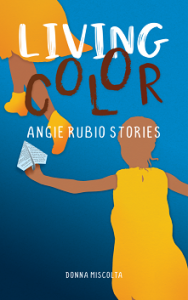Authors Interviewing Characters: Donna Miscolta
 Living Color: Angie Rubio Stories
Living Color: Angie Rubio Stories
Set in California in the 1960s and ’70s, Living Color: Angie Rubio Stories takes Angie year by thorny year from kindergarten through high school, offering an often humorous, sometimes biting, but always compassionate portrait of the artist as a shy, awkward Mexican-American girl.
Taking place against the backdrop of the Cold War and civil rights eras—the Cuban missile crisis, the Watts riots, Beatlemania, the Black Power salute at the 1968 Olympics—Living Color: Angie Rubio Stories surveys the milestones of American girlhood, through which Angie stumbles, while tracing her formation as a writer.
Each story in this collection represents an event or experience in a particular grade in school, a life lesson about winning and losing, belonging and not belonging, or about overcoming the divisions in life that can be caused by race, gender, or just a different way of walking through life. Whether the issue relates to skin color, body image, sexual awakening, or some other aspect of peer and social pressure or the mere act of growing up, the stories cohere to tell a story of Angie’s struggle to find out who she is and where her place is in the world.
Donna Miscolta interviews Angie Rubio
When you look back on your life, is there a particular event that you feel was a turning point for you?
I think every story in the book marks a turning point of sorts. Remember the story called “Monster”? What happened to Susie was traumatizing. Even though I wasn’t the one who directly harmed her, I told her to go away and not come back. So of course I felt guilt. Fear, too, at the power of my thoughts. I learned that something bad could live inside of me. On the other hand, there are other stories in which I felt vanquished, yet somehow hopeful that tomorrow or the next day or the day after that would be better, if still complicated.
Like the story called “Current Events” where everything seems to go wrong in my fifth-grade existence, but then JFK is assassinated and the whole darn world is bleak. Yet looking at the picture of him my mother cut from LIFE magazine where he’s gazing into the distance at a future he’ll never live, I could still imagine that a future existed, changed, but surely there. I’ve stored all these micro-epiphanies somewhere inside of me. They’re jumbled like a pile of dirty laundry, with bits and pieces of each individual piece visible in the mix.
When did you first realize that your skin color mattered?
Well, the first story in the book is about my disastrous kindergarten experience. Disaster and kindergarten should never be in the same sentence, right? The realization on that first day of school that I was different came of my own observation. No one pointed it out to me. There was no outright cruelty. Just an undercurrent of quiet judgment in the classroom. I felt a sense of not belonging, of not counting as much as the other kids around me. That feeling never changed. Sometimes it was subtle, like the time I was in Catholic school in the second grade and my big concern was sin. Sometimes it screamed like a siren, like when I was in third grade and wanted to join the Brownies. Oh, what an unfortunate goal for a brown girl.
If you could sum up your life in a song, what would it be?
Ball of Confusion? See, I even put a question mark after it to indicate my dithering, ongoing mystification of the world and my place in it.
Of all the years of your life recounted in these stories, which was the worst and which the best?
Are you talking craft or content? On the craft aspect, I give you kudos. Each story is lovingly told with humor and pathos. It’s been a pleasure to have been depicted with such care and fidelity. Of the actual events recounted of my life in these stories, I’d say the worst was being told I was in the “dumb class.” By what metric was I judged? I knew I wasn’t dumb, yet someone had categorized me that way. It was a soul-ripping moment. I think the best happens in the last story of the book when I wholeheartedly, if a bit recklessly, speak my mind. Of course, I was older by then. After having been a pushover in so many of the previous stories, it was about time I acted decisively.
How do you think your teachers in these stories would predict your future trajectory?
 Mrs. Pai, my tormentor in kindergarten, would predict a life of unfinished school lunches along with repeated reprimands for wasting food.
Mrs. Pai, my tormentor in kindergarten, would predict a life of unfinished school lunches along with repeated reprimands for wasting food.
Miss Leake, my fourth-grade teacher who would not confirm that her class was designated as the dumb class, in which I was voted class president, would predict upward mobility to the smarter classes in which I would never again be voted class president.
Mrs. Brimsler, my Sex Ed teacher, would have low expectations of me as an experiential learner, regarding me more as a theorist.
Mrs. K, my junior high English teacher who had great confidence in my abilities and observed that I had “a bent for the written word,” and Mr. Otto, my high school English teacher, who called my eleventh-grade project “provocative,” would be the ones who would appear on a This is Your Life, Angie Rubio type of show where the producers organizing a retrospective of my accomplishments would bring them on stage to beam at me in my seat of honor. Mrs. K would fondly recall her perceptive noting of my “bent” and Mr. Otto would raise his now even furrier eyebrows in an approving way and remind me of the time he had to mark me tardy for arriving late to class to turn in my assignment. We would all laugh heartily, and eyes would brim at our lost youth.
—
Donna Miscolta is the author of three books of fiction, the most recent of which is Living Color: Angie Rubio Stories. She’s also the author of the story collection Hola and Goodbye and the novel When the de la Cruz Family Danced. Watch the book trailer for Living Color: Angie Rubio Stories at donnamiscolta.com.
Category: Interviews, On Writing






























